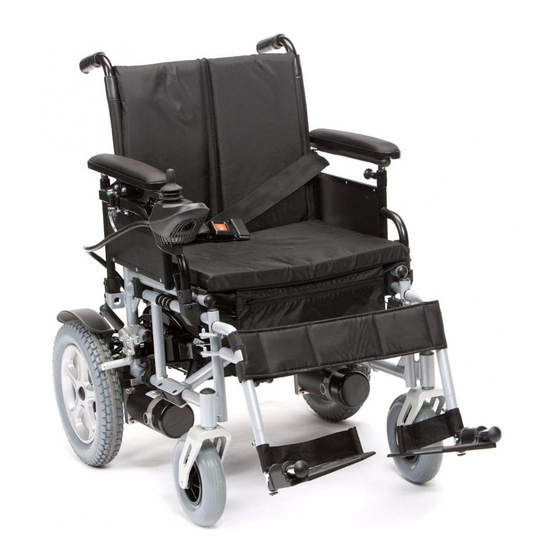
Summary of Contents for Drive CIRRUS
- Page 1 CIRRUS POWERCHAIR OWNER’S HANDBOOK Cirrus Powerchair Owners Handbook Page 1 of 24 Doc Code: PCC_IFU (02/15)
-
Page 2: Table Of Contents
Disassembly INTRODUCTION The Cirrus powerchair has been designed for a single occupant user mass of up to 135kg. The design of the powerchair assumes that the user has limited mobility but has the physical, visual and cognitive ability to operate the powerchair safely. -
Page 3: Personal Safety
Ensure that any modification made to the powerchair are approved by Drive Medical. Unauthroised modifications may reduce the performance of the powerchair, invalidate the warranty, or result in injury or damage. - Page 4 The interference (from radio wave sources) can cause the powered wheelchair to release its brakes, move by itself, or move in an unintended direction. It can also permanently damage the powered wheelchair’s control system. Cirrus Powerchair Owners Handbook Page 4 of 24 Doc Code: PCC_IFU (02/15)
- Page 5 Following the warnings listed below should reduce the chance of unintended brake release or movement as a result of EMI: Cirrus Powerchair Owners Handbook Page 5 of 24 Doc Code: PCC_IFU (02/15)
-
Page 6: Parts Description
Powerchair). 5. Report all incidents of unintended movement or brake release to the Powerchair manufacturer and note whether there is an EMI source nearby PARTS DESCRIPTION Cirrus Powerchair Owners Handbook Page 6 of 24 Doc Code: PCC_IFU (02/15) -
Page 7: Control Functions Operation
PARTS DESCRIPTION (CONTINUED) CONTROL FUNCTIONS OPERATION Joystick Control Panel (shown above) Cirrus Powerchair Owners Handbook Page 7 of 24 Doc Code: PCC_IFU (02/15) - Page 8 Do not use the on/off button to stop the wheelchair unless there is an emergency. (If you do, you may shorten the life of the wheelchair drive components). The battery gauge shows you that the wheelchair is switched on. It also indicates the operating status of the wheelchair.
- Page 9 The more LEDs are lit, the faster the maximum speed. The wheelchair can be configured to use drive profiles. However, this is not included by default. For more information about drive profiles, contact your dealer. If the speed indicator ripples, this means the wheelchair is locked.
- Page 10 This is where the Speed Indicator and 10 bars are lit. A communication fault is indicated. Make sure that joystick 10 Bar + cable is securely connected and not damaged. Speed Cirrus Powerchair Owners Handbook Page 10 of 24 Doc Code: PCC_IFU (02/15)
- Page 11 There is a risk of suffocation from users and/or occupied, the motors should ‘submarining’ (where they slide down always be set to DRIVE to ensure the the chair until the lap belt is around the automatic brakes function. neck area). To reduce the risk of this, ensure that the lap belt is used under supervision and is used as instructed.
-
Page 12: Adjustments For Comfort
The height of the foot rests can be position. altered by loosening the adjustment screw. Cirrus Powerchair Owners Handbook Page 12 of 24 Doc Code: PCC_IFU (02/15) - Page 13 Velcro. You will then see four straps which determine the tautness of the canvas. Adjust these until you are comfortable, then secure the straps with Velcro. Cirrus Powerchair Owners Handbook Page 13 of 24 Doc Code: PCC_IFU (02/15)
- Page 14 ASSEMBLY, DISASSEMBLY AND TRANSPORTATION ASSEMBLY: Cirrus Powerchair Owners Handbook Page 14 of 24 Doc Code: PCC_IFU (02/15)
- Page 15 Cirrus Powerchair Owners Handbook Page 15 of 24 Doc Code: PCC_IFU (02/15)
- Page 16 Cirrus Powerchair Owners Handbook Page 16 of 24 Doc Code: PCC_IFU (02/15)
-
Page 17: Disassembly
The powerchair is not suitable for use as a seat in a motor vehicle, so the wheelchair occupant should always exit the chair and transfer the vehicle’s seat before travelling. Cirrus Powerchair Owners Handbook Page 17 of 24 Doc Code: PCC_IFU (02/15) -
Page 18: Battery Charging
If you find the fan does not work when the amber LED is lit, DO NOT use the charger. To do so may result in the charger overheating and risk of fire. Cirrus Powerchair Owners Handbook Page 18 of 24 Doc Code: PCC_IFU (02/15) - Page 19 It is for this reason that the batteries must be correctly charged at all times else the peak point reached may not be the batteries’ optimum capacity and their lifespan may be reduced. Cirrus Powerchair Owners Handbook Page 19 of 24 Doc Code: PCC_IFU (02/15)
-
Page 20: Care And Maintenance
Check the charger. If the fan on the The powerchair should be serviced charger is not working whilst the annually by an approved Drive amber light is lit, do not use the Medical service agent. A service log charger... -
Page 21: Service Record
Locking Mechs Service Year 1 Year 2 Year 3 Year 4 Year 5 Dealer Sign / Date Customer Name Date of Purchase Address Colour Serial No. Options Included Postcode Cirrus Powerchair Owners Handbook Page 21 of 24 Doc Code: PCC_IFU (02/15) -
Page 22: Troubleshooting
Check the batteries are charged up. Check all the connections are linked correctly. Please also refer to the section about the Controller Information Gauge on page 8 of this manual. Cirrus Powerchair Owners Handbook Page 22 of 24 Doc Code: PCC_IFU (02/15) -
Page 23: Specification
24V DC 4A Remark: The manufacturer reserves the right to modify the specification if necessary. The final specification is subject to the individual powerchair you purchase from your dealer. Cirrus Powerchair Owners Handbook Page 23 of 24 Doc Code: PCC_IFU (02/15) - Page 24 The warranty covers the powerchair for repairs or replacement during this period. For more detail, please see the warranty conditions below: Any work or replacement part installation must be carried out by an authorised Drive Medical dealer / service agent.

















Need help?
Do you have a question about the CIRRUS and is the answer not in the manual?
Questions and answers